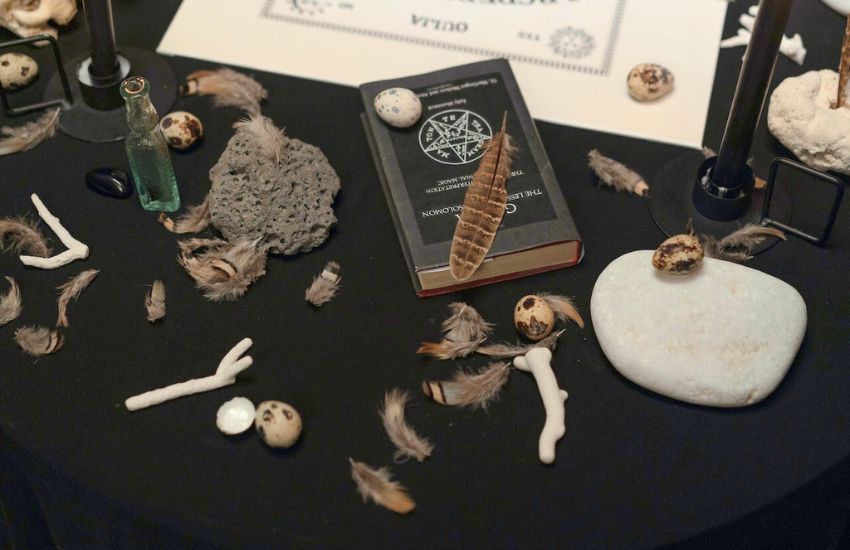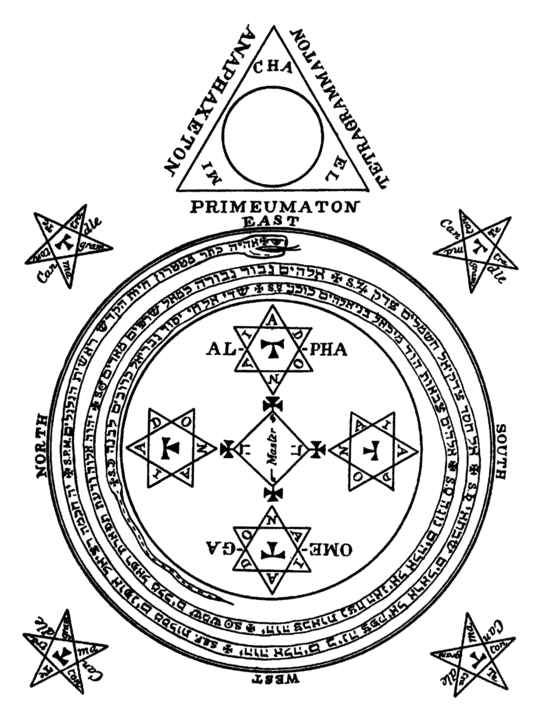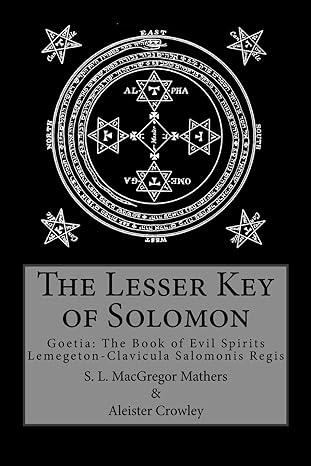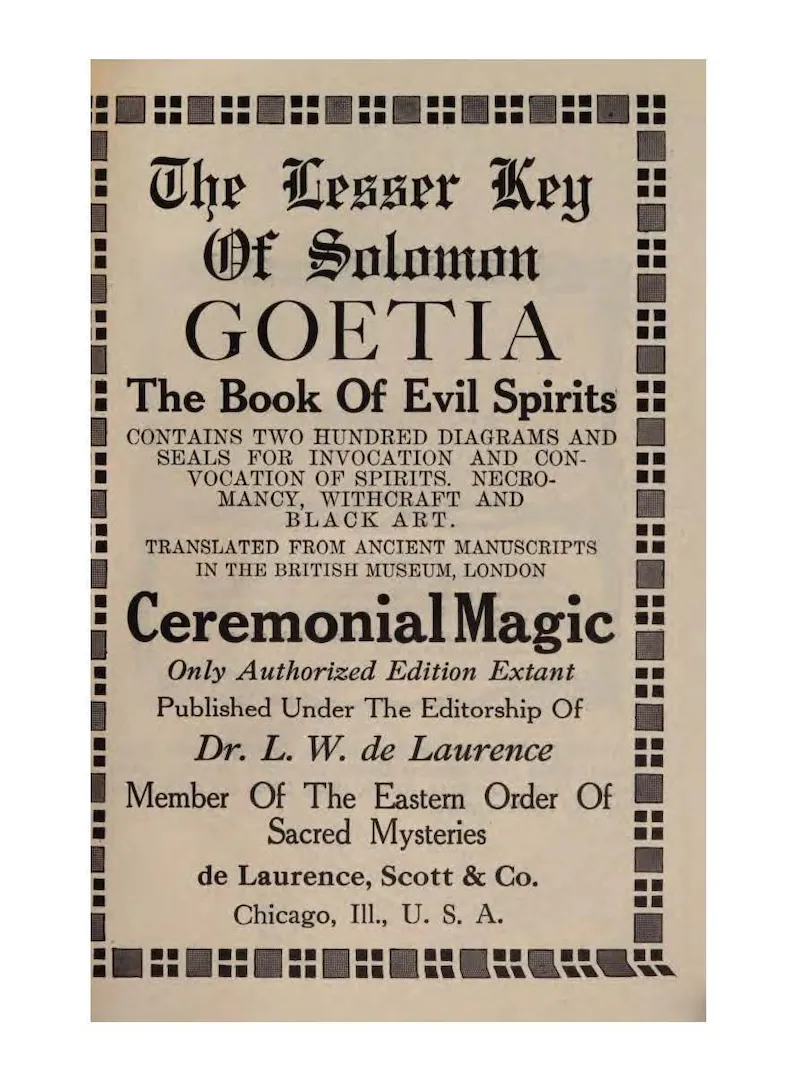
Table of Contents
The Lesser Key of Solomon, also called Lemegeton, is one of the most comprehensive books of magic ever written. Owners of the original manuscript reported strange happenings after getting their hands on the book, like the book flying off the shelf on its own and hearing whispers and seeing dark shadowy figures near the book.
But others see the Lesser Key as a practical guidebook, a workbook containing extensive information on demonology, spells, and rituals. While we can’t vouch for its power or veracity, it’s interesting that this text has endured so long and continues to be a source of interest for historians, magicians, and anthropologists alike. But what is it really about and why is it so controversial?
Who Authored the Lesser Key of Solomon?

Did Solomon really write this text? Scholars think no. Like all the grimoires assigned to him, this too appears to be a pseudepigrapha, that is, written by an unknown author or authors and falsely attributed to Solomon. If you watched our video on the Testament of Solomon, we talked about how sometimes authors would attribute their work to more famous, well-known people to give their text legitimacy and credibility.
Scholars believe that the text was compiled some time in the mid-17th century but drew on much older materials. The text is called the lesser key of Solomon simply to distinguish it from another work, the greater key of Solomon.
The “lesser” in “Lesser Key of Solomon” does not suggest it is of lesser importance or quality. It just deals with different things compared to the greater key of Solomon.
Five Sections of the Lesser Key of Solomon

The Lesser Key of Solomon dates back to the Middle Ages, a time when grimoires were becoming very popular. It’s divided into five distinct sections.
Section 1: Ars Goetia
The Ars Goetia, the first and arguably the most famous section of the Lesser Key, presents detailed descriptions of 72 different spirits or demons, and their corresponding ranks and powers.
Solomon’s power and control over demons is initially mentioned in the Testament of Solomon, which is one of the earliest grimoires and a foundational text of Solomonic magic.
In the Ars Goetia some of the same demons make an appearance. But the text goes into a lot more detail. It lists 72 demons, their sigils, their ranks (such as marquise, duke, king, and so on), and pretty much everything you need to know about them.
That’s why this list of demons is considered one of the most comprehensive in Western occult tradition. Each of the demons is defined with a unique characteristic. Some are teachers of sciences, some provoke love, and others grant invisibility.
Each is represented by a sigil drawn with detail in the text. The demons prefer to keep these hidden, because the sigils can be used to control them. The text also details the necessary rituals, symbols, and incantations needed to invoke and control the demons, so they do your bidding.
While this might sound like terrible black magic, the text doesn’t indicate that. You might say that it’s all about getting the demons to do divine work, much like how King Solomon enslaved the demons to create the temple of Jerusalem.
Section 2: Ars Theurgia Goetia
The second section, Ars Theurgia Goetia, focuses more on theurgy, which is the practice of rituals, rather than demonology. It also introduces a whole host of spirits, such as the spirits of cardinal directions and their respective minions.
These spirits are deemed not to be evil, although they’re very rebellious. It appears that they need to be invoked very carefully and with proper management.
Section 3: Ars Paulina
The Ars Paulina, the third section, deals with planetary spirits. It speaks of angels associated with each of the 360 degrees of the zodiac and the hours of the day and night.
This section offers detailed protocols for summoning these angels and utilizing their assistance effectively.
Section 4: Ars Almadel
The fourth section, Ars Almadel, outlines the creation of a magical wax tablet, or Almadel, used for summoning the angels of each of the four altitudes.
It’s a freestanding section, meaning you don’t have to do any of this magic in conjunction with the others. These angels are claimed to provide valuable information about future events and grant favors when approached with the proper ritual.
Section 5: Ars Notoria
The final section, Ars Notoria, consists of prayers and rituals that can give the magician perfect memory and masterful learning abilities. This section includes mnemonic devices that are designed to help the practitioner in the acquisition of knowledge. It’s focused on how to acquire wisdom and learning quickly.
A Practical Guidebook
As you can see, unlike a text like the testament of Solomon which is a narrative, the lesser key of Solomon has practical steps you can take if you want to enter into the world of demonology, magic and rituals. To those who believe in magick and demonology, this is a grimoire of great importance.
In fact, you’ll even find comments like this one, which highlight just how highly regarded the Lesser Key of Solomon is among occult practitioners.
“If you haven’t evoked a spirit before, I don’t recommend starting with the Goetia. You have to really know what you’re doing to handle demons, so if you don’t know what you’re doing, practice with a god or some other spirit that you know is benevolent.”
So, whatever your feelings might be about the this text, it’s one that evokes, if nothing else, strong feelings by people on either side of the aisle.
Importance of the Lesser Key of Solomon

The Lesser Key of Solomon, despite its age, continues to hold a significant place in contemporary culture and practice. Historians, anthropologists, and religious studies scholars often employ the text as a reference to understand the evolution of Western occultism and magical practices.
For others, the book serves as a metaphorical guide, offering insights and provoking introspection for personal growth. For example, certain practitioners of ceremonial magic and certain occult groups deem the Lesser Key of Solomon a practical guide, performing its rituals and incantations as part of their magical operations.
They may interpret the entities in the text either as literal supernatural beings or symbolic representations of natural forces or psychological archetypes.
Is the Book Dangerous?
While we don’t have any scientific evidence that claims that the book is dangerous or cursed, there are other reasons to take care when handling the Lesser Key of Solomon. Despite the text’s historical and cultural importance, it is essential to approach the Lesser Key of Solomon with a degree of caution.
The rituals it contains, relating to invocation and interaction with supernatural entities, are considered dangerous or taboo in many cultures. Misuse or misinterpretation of these rituals, according to some belief systems, could potentially invite misfortune.
Whatever your stance is on the lesser key of Solomon, there’s no denying that this is a book that captures everyone’s interest.
Wrapping Up
The Lesser Key of Solomon is an important text. It offers a fascinating glimpse into the realm of ceremonial magic and demonology. Through its intricate rituals, invocations, and the detailed description of the 72 spirits, the text emphasizes humanity’s age-old desire to understand and perhaps harness the unseen forces around us.
Related articles
What is the Testament of Solomon and Why Isn’t It in the Bible?
Seal of Solomon – Symbolism, Meaning and Importance








